Electric vehicles rely on a power-supply connection, which is essential for efficient and safe powering. The charging cord connects your EV to the charger, supplying it with power. The EV cable consists of a socket, wire, and car connection.
The right EV power connector boosts charging speed, ensures compatibility, and enhances user experience. Choose an EV power connector based on your vehicle model, charging infrastructure, and future-proofing needs.
Choosing the right plug not only enhances the charging experience but also ensures long-term compatibility. Understanding regional charging standards helps in making informed decisions. Seeking expert advice or adhering to manufacturer recommendations is crucial in selecting the most suitable EV power connector for your electric vehicle.
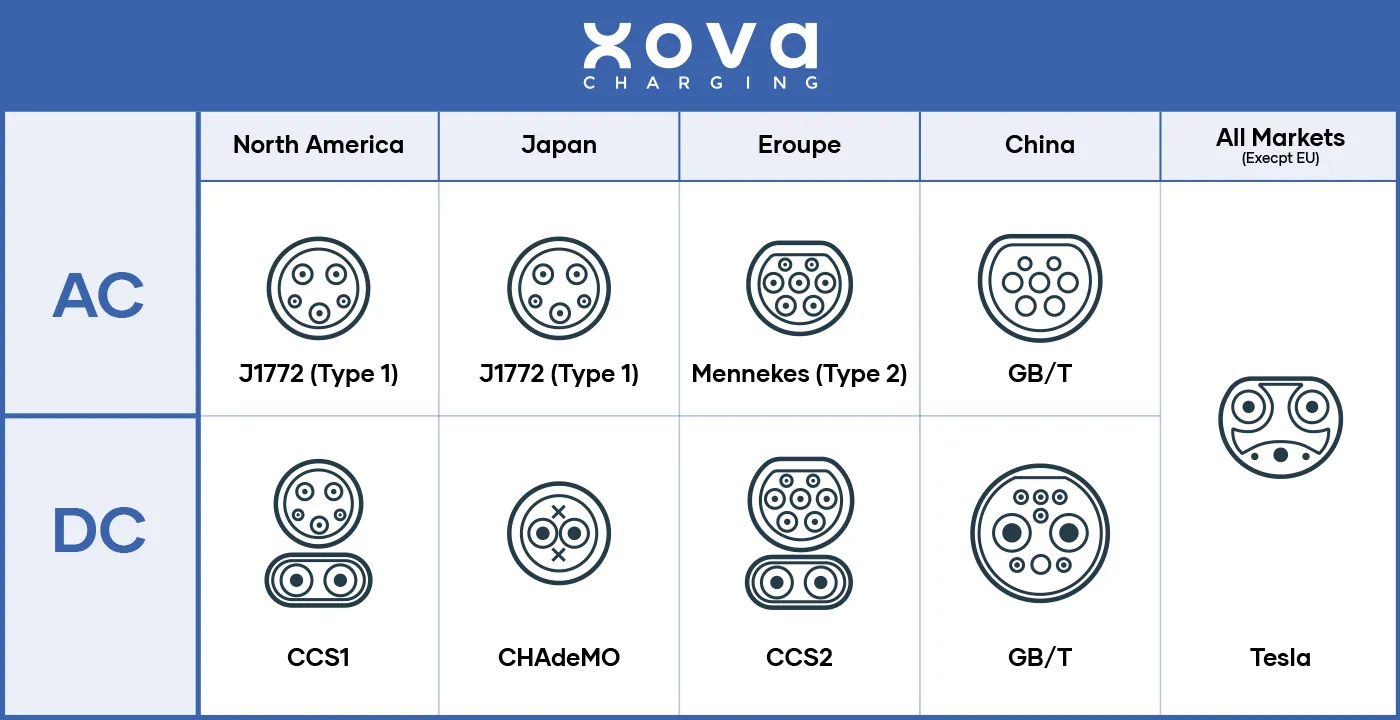
Selecting a Safe and Future-Proof EV Connector
An electric vehicle connector that matches the energy supply station is crucial to prevent damage to both the vehicle and the station. An incompatible connector can result in the vehicle overheating or short-circuiting.
It also helps future-proof your charging setup as new technologies and standards emerge in the EV industry.
How to Choose the Right EV Connector:
Here, we provide all the necessary information to help you navigate the various options and make an informed decision based on your specific requirements and preferences.
EV Charging Connectors
Different types of plugs are available for EV cables, facilitating easy identification of the compatible connector for your electric vehicle. Such as :
● Type 1 (SAE J1772)
● Type 2
● CCS
● CHAdeMO
While Type 1 and Type 2 connectors are compatible with fast chargers, CCS and CHAdeMO connectors are specifically designed for rapid chargers, offering varying charging speeds and capabilities. Conventional electric car models typically use Type 1 cables, while more modern models come with Type 2 cables.
|
SI.No |
Types of CGs |
Specification |
|||
|
|
|
PHASE |
INPUT |
OUTPUT |
POWER |
|
1 |
Type 1 AC (SAE J1772) |
Single Phase |
120-240V |
16-80A |
19.5KW |
|
2 |
Type2 AC |
1/3 phase |
230-400V |
32A |
7.6-22 KW |
|
3 |
CCS Type1 |
DC-3 phase |
480-1000V |
500A |
360KW |
|
4 |
CCS Type2 |
DC-3 Phase |
400-1000V |
500A |
360KW |
|
5 |
CHAdeMO |
DC-3 Phase |
400V |
400A |
400KW |
|
6 |
TESLA (AC\DC) |
1\3 Phase |
|
48A (AC) 400A (DC) |
250KW |
|
7 |
GB/T |
AC-3 Phase |
250V |
250A |
7.4kW |
|
|
|
DC |
440V |
250A |
237.5kW |
Type 1 connectors :
SAE J1772, (J plug or Type 1)
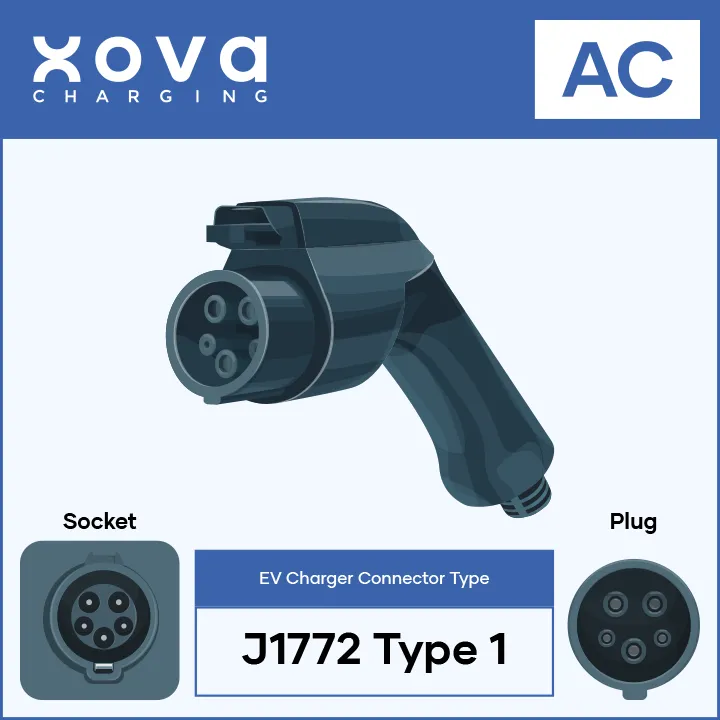
Upgrade your e-fueling experience with the reliable and widely adopted SAE J1772. This electrical connector is the energy-fueling standard for zero-emission vehicles in North America and Japan. Because of its adaptability to different charging configurations, it can handle a wide range of AC power rates. It comes with five pins, including
● AC Line 1
● AC Neutral
● Protective Earth
● Proximity Pilot
● Control Pilot
It ensures compatibility and convenience. Safety features such as shock protection and prevention of power pin disconnection are in place to enhance safety. It also includes features like automatic locking and weatherproofing, making it a user-friendly and durable option for e-vehicle charging. This connector is reliable as it is widely used in nearly all North American electric cars and plug-in hybrids. Even Tesla drivers can charge using a J1772 charger with a compatible adapter. The solution is both reliable and adaptable, making it ideal for electric car owners.
Overview of the SAE J1772 EV Connector
• Primarily used in North America, Japan, and Canada.
• With 240-volt input, it can charge 80 amps with five pins.
• Maximum EV charging power: 19.2 kW.
• It prioritizes safety with shock protection and power pin disconnection prevention.
• Drawback: It only allows single-phase use and lacks an automatic locking mechanism.
Mennekes; Type-2 Connectors :
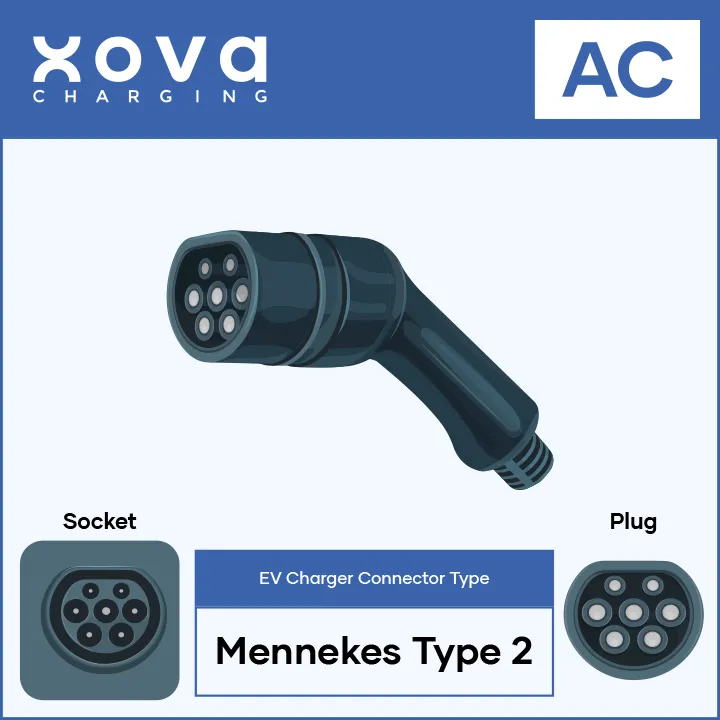
In Europe, plug-in vehicles use this standardized connector, the Mennekes. The German Automotive Industry Association and European Automobile Manufacturers Association standardized it after Mennekes designed it in 2009.
The device has a circular shape, a flattened top edge, and seven signaling and power supply pins. In single-phase and three-phase AC, it can produce 43 kW.
It is widely accepted as the standard connector globally, and Tesla utilizes it for its European Supercharger network. Europe, North America, and China intend to replace previous vehicle connectors used for AC charging with the Type-2 plug. It is part of the Combined Energy Fueling System Combo 2, allowing rapid charging with direct current power.
Overview of IEC 62196 Type 2 Connector
• Known as the Mennekes connector.
• generally used in the US, UK, USA, Africa, and Australia.
• Seven-pin 400-volt inputs can charge 32 amps.
• Permits Level 2 chargers to use either a single-phase or a three-phase AC socket.
• When charging, the plugs automatically lock to keep the cable in place.
• Both type-1 and type-2 use the same signaling protocol, allowing uniform production.
CCS Connectors:
The Combined Charging System (CCS) sets the benchmark for charging electric vehicles. With either Combo 1 (CCS1) or Combo 2, you can quickly recharge your car to a maximum of 350 kW (500 A). Widely used around the world, these are popular because they can handle high power levels and integrate with multiple EVs.
CCS Type 1 Connector
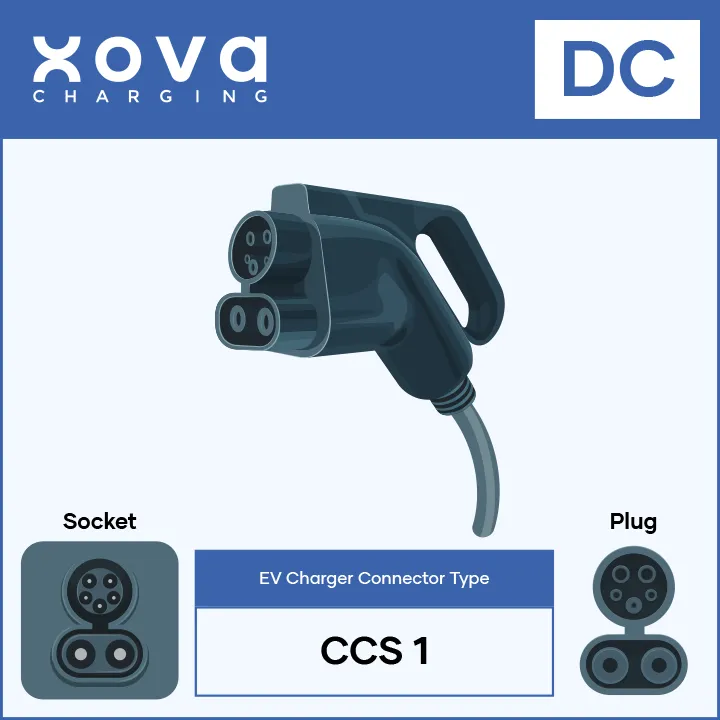
Charge systems with a maximum power output of 360 kW, 500A, and 1000V DC are available with the CCS Combo 1 connector, which combines the J1722 Type-1 plug with two powerful DC fast charging pins.
It’s widely used in American and Asian e-vehicles, providing convenience to North American owners. It’s also compatible with most public power stations but is less common in Europe than in the CCS Type-2 plugs.
Unlike other manufacturers, Tesla vehicles primarily use their proprietary Supercharger network with unique plug designs. Adapters differ from industry standards due to their focus on their energy supply infrastructure, demonstrating that not all EV manufacturers adhere to the same charging port standard.
CCS1 Type 1 Overview
• Includes a J1722 Type-1 plug with two Speedy DC pins.
• Identified as the North American standard for fast DC charging at level 3.
• Prominent in the American, Canadian, and Korean markets.
• It’s capable of supplying DC at 500A and 1000V.
• Typically, North American EVs use the CCS-1 plug.
• Japanese cars also shift from CHAdeMO to CCS1.
• Tesla has a North American charging standard.
CCS Type 2 Connector :
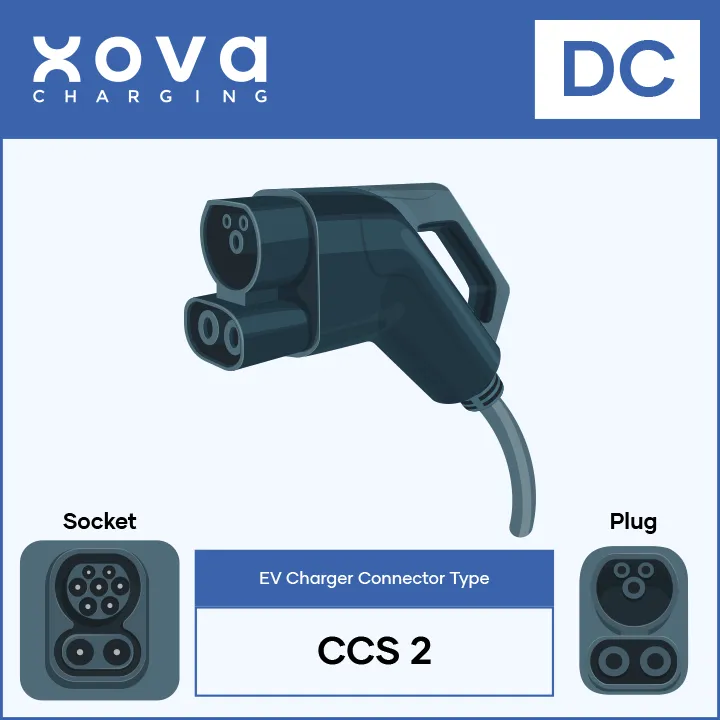
It is also known as the Combo 2 and is a widely adopted standard to charge EVs, predominantly in Europe. The integration combines the Type 2 plug’s AC powering capability with additional DC pins, allowing for slow and quick DC supplies. It is a highly versatile option that can accommodate various power speeds, from standard home charging to high-speed power stations.
Europe widely uses and endorses this device for AC charging. It features two extra DC pins for accelerated DC power. It can deliver up to 43 kW of power in AC mode, but when combined with DC charging, it can reach 350 kW, allowing faster e-fueling times.
The European Commission has recognized the CCS Type-2 as the standard for rapid charging in the region, promoting compatibility between car manufacturers and electric car station operators. It offers a quick and dependable energy system that works with various environmentally friendly vehicles.
Overview of CCS Type 2 :
• Primary in Europe, the UK, the USA, Africa, and Australia.
• The Mennekes Type-2 plug is joined with two high-speed charging pins.
• Can supply up to 500A and 1000V DC.
• Provide max power output 360 kW.
CHAdeMO EV Connectors :
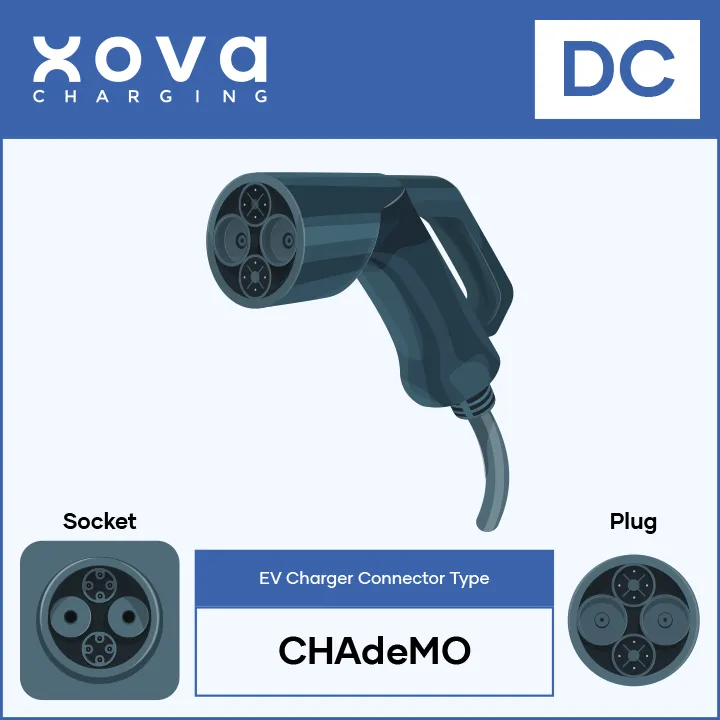
The CHAdeMO Association and Tokyo Electric Power Company developed CHAdeMO, a fast-green system for EVs, in 2010. The CHAdeMO system, derived from the Japanese phrase “o CHA deMO ikaga desuka,” provides a secure and practical method for charging your vehicle, resembling the phrase “How about a cup of tea?”.
CHAdeMO allows for rapid charging, adding 120 kilometers of range in 30 minutes. The second-generation specification offers even faster charging with up to 400 kW of power. The CHAdeMO Association is working on the third-generation standard, “ChaoJi,” which aims to deliver an impressive 900 kW of power.
CHAdeMO also offers vehicle-to-grid integration, allowing EV owners to use their cars as energy storage devices. In collaboration with the China Electricity Council, CHAdeMO is developing the next-generation ultra-high-power protocol, CHAdeMO 3.0, which will harmonize the system with the CEC GB/T powering standard and increase the charging rate to 900 kW.
Overview of CHAdeMO EV Charging connector :
• Developed by Japanese automakers, a DC fast-charging standard.
• They’re very popular in the US and are used extensively in Asia.
• The power output of 400 kW at its peak to charge electric cars.
• To achieve 400 kW output, liquid-cooled cables like CCS types are needed.
• It is predominantly used in Japan for DC fast recharge.
• Ongoing development with “ChaoJi” technology for faster recharge.
• Allow one EV charger port; CHAdeMO requires a separate AC power port.
The GB/T AC and DC Connector :

The GB/T 20234 family of standards is designed to facilitate efficient AC and DC rapid charging of electric vehicles in China, encompassing a wide range of specifications to enhance the charging infrastructure for electric automobiles.
The key parameters are as follows:
- The male connector has a diameter of 65 mm (2.6 in),
- There is a dedicated pin for the Earth connection.
- The maximum current it can handle is 250 A.
- The maximum voltage it can handle is 1000 V.
- The device has a total of nine (9) pins.
These are categorized as follows:
- One pin for ground connection,
- Two pins for DC power,
- Two pins for auxiliary power,
- Four pins for signaling.
- Signal type: direct current (DC)
Considerations for Selecting the Perfect Connector
1. Compatibility with your vehicle:
Choose based on your vehicle’s compatibility, charging station availability, matching input type, and required energy speed. Ensure the product has advanced functionalities, such as intelligent charging capabilities, and seamlessly integrates with renewable energy sources.
2. Charging speed:
Pick a suitable one for your electric vehicle by considering its charging power and speed capabilities. Various connectors provide different speeds, and opting for a larger power output can decrease the time required to charge. Additionally, some offer the option to modify the speed or receive notifications.
3. Convenice and accessibility
Decide on a readily available and intuitive connector to facilitate convenient access to charging outlets and effortless car recharging. Select options that are easy to use and thoughtfully crafted to prioritize user ease.
What Every EV Driver Needs to Know?
Determine your vehicle’s inlet type.
Identifying your vehicle’s inlet type is crucial for selecting the correct EV connector, ensuring compatibility and a secure plugging experience. Researching your vehicle’s input type prevents issues and provides a selection that suits your needs.
Research the available charging connectors in your area.
Getting the right power connector for your electric vehicle requires analysis through nearby options. In order to make a well-informed choice, it is crucial to comprehend features, price, and compatibility. Additionally, considering features like durability and user-friendliness can ensure a smooth battery charge experience.
Consider your charging needs and preferences.
Consider these factors when selecting an EV connector:
1. Charging Speed – How quickly you need to charge your EV.
2. Vehicle Compatibility – Ensure your car supports the connector type.
3. Safety Features – Look for overcharge protection and weatherproofing.
4. Ease of Use – Choose a user-friendly design with a secure lock.
5. Future-Proofing – Consider upcoming EV charging technologies.
Choose them based on your needs for convenience, safety, and reliability. Compare options and read user reviews to ensure a streamlined green fueling experience, benefiting your electric vehicle with reliable and efficient fueling.
Conclusion
To identify the ideal one, you need to know the different types of connectors out there, figure out how much charging you need, and consider how compatible your car is with where you live. Following these instructions will help you make an informed decision for an EV charging setup that is well-prepared for the future.
FAQs About EV Charging
Browse our frequently asked questions or get in touch!
